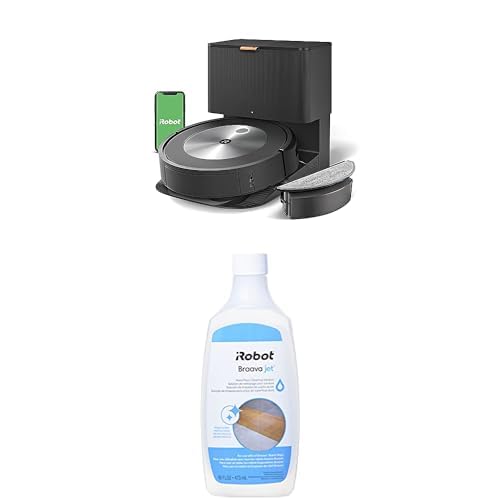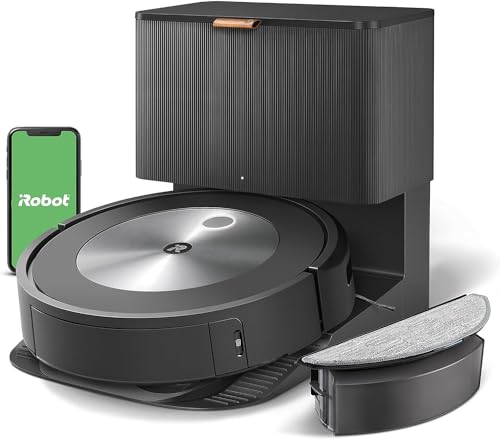The Main Issue With Bagless Self Emptying Robot Vacuum And How You Can…
페이지 정보
Writer : Melvin
Date : 24-09-09 22:28
Hit : 110
Related Link
본문
 Bagless Self Emptying Robot Vacuum
Bagless Self Emptying Robot Vacuum These robovacs are excellent at picking up dust however they can also be trapped by lamps, toys and other obstacles. The dust bins have to be emptied manually every few cleaning cycles.
These robovacs are excellent at picking up dust however they can also be trapped by lamps, toys and other obstacles. The dust bins have to be emptied manually every few cleaning cycles.Self-emptying robot vacuums will automatically transfer their collected debris into an interior storage system. This is typically a larger base which can hold up to a 60-day worth of garbage. This is a fantastic option for those who have an extensive home or who have frequent messy areas.
Battery life
A robot vacuum's battery life is typically measured in the number of days or cleaning sessions it is able to handle on a single charge. This is a good method of assessing its ability to clean. The same can be said for the self-emptying models that take the dirt that has accumulated from their tiny dustbins and deposit it in an interior base storage bin. This feature allows you to run your robot more frequently without the need empty the dustbin and reload it between sweeps.
When a robot's trash bin is full, it will return to its charging dock where the accumulated debris is taken away in the form of a loud "whoosh" and then dropped into a base canister that is about a foot high that houses a disposable paper bag. The canister could be filled with any type of garbage bags, however some owners prefer the environmental benefits and convenience of a bagless system that is specifically designed for this purpose.
During the mapping process, the self-emptying robot's internal sensors and GPS locate your home and take a floor plan to form an internal map. Then, it utilizes this map to move around your home, sweeping the rooms and floors as it goes. They are great for cleaning up messes that other robot vacuums could have missed, like dirt, dust and hair that has accumulated under furniture or behind a pet's bed.
Self-emptying self-empty robot vacuum vacuums can also deal with wet spills, an excellent feature for families with children and pets. They're also a great option for homes with bigger spaces because they can cover a larger area per sweep.
For the best robot vacuum for pet hair self emptying performance from your robot, select an option with a large, easy to remove bin, and a short recharge time. Think about the size of your house to determine the amount of space you will require. If you have a very large home, you might choose dual-battery models that will run for as long as two hours. Make sure you regularly clean the rotating brushes of a robot vacuum (especially if you have a hair-clinging breed) and clean the charging contacts and sensors every now and then. This will help extend the life of your battery vacuum and ensure it is functioning at its peak.
App control
While a robot vacuum will assist in keeping your home tidy and clean but it's not a substitute for a thorough cleaning. Before you let your robot vacuum go make sure that the filters are clean and all cords are out of the path. To ensure that your robovac is operating properly, you should empty the bin regularly and clean the charging sensors and contact.
A robotic vacuum uses cameras, sensors and lasers to guide you around your home. It will then remove pet hair, crumbs and dirt from hard floors such as tile, hardwood, and laminate. Advanced models can create precise maps, allowing you to label different rooms or even set up virtual no-go zones. Some models can even detect stairs and even more affordable models come with boundary strips that can be used to block off stairs and other areas you don't want the robot to get into.
Many of the best self cleaning robot vacuum robots vacuums have intelligent features that allow them to be connected to your smartphone or tablet to control remotes as well as schedule maintenance and receive instructions. Some robot vacuums connect to Amazon Alexa or other digital voice assistants, allowing an unidirectional experience. Other models have long battery life, quiet modes and attachments to tackle difficult spots.
Self-emptying robot vacuums are particularly beneficial in larger homes where it is difficult to empty the trash bin every day. When the bin is full it will stop removing debris and instead move any mess from the floor around the base before transferring it to its docking station. Some models come with a large, bagless base that can store over a month's worth of debris, and it can be easily emptyed without touching the debris.
Some robots are also able to mop and sweep. This makes them ideal for homes that have both hard and softer surfaces. The Roborock S7 MaxV Ultra is a great example, as it can vacuum and mop floors effectively with its powerful engine and multi-surface cleaning system. It also has an onboard camera which allows you to view the space in real-time and also a mopping pad which can be cleaned out in a blink of an eye.
Range
A vacuum that is able to empty itself without a bag is a great option for any house, but particularly large ones. It can help you clean your home according to a schedule without having to worry about emptying the dustbin each time. It can also prevent the release into the air of tiny particles, which is crucial for those suffering from allergies.
The most effective robot vacuums that are bagless and self-emptying are powerful enough to handle most cleaning jobs in homes. They make use of specialized sensors and cameras to identify obstacles and avoid them while cleaning. They can also identify and mark different areas and create virtual "no go" zones. This can help keep your robot from your pet's favourite spot or your kids' toys.
Some of the more sophisticated models have a self-emptying dock that allows you to store and take away particles from the garbage bin. This is a great convenience for parents trying to balance their household duties with a full-time career and kids. A dock with large storage allows you to run the robot more frequently and also maintain a tidy home.
Self-emptying robot vacuums are typically rated in terms of the amount of debris they can hold and can store 30 to 60 days of dirt. They are also evaluated based on how loud they sound when they move the dust from their bin to the dock which is a crucial aspect for those who live in apartments and condos.
A smaller dustbin will generally fill up quicker than larger ones, and you will need to empty it more frequently. To determine the size of the bin that you require and also take into account the size of your house. If you can, it's ideal to choose a model with a large capacity to ensure that you can use the dustbin for longer.
A Best bagless self emptying robot vacuum self-emptying robot vacuum (Link Home Page) is a great option for families with pets or children, as it will help you avoid the hassle of emptying it every day. However, it is not a good option for areas with a lot of mess, such as kitchens and dining rooms. It isn't easy for a robot cleaner to clean areas that are full of food items, trash and other things.
Noise
This vacuum comes with a superb navigation system that lets it avoid obstacles that often trip up other vacuums like tangled cords, tangled wires, and other debris. It is also a powerful edge cleaner, and has enough suction to remove debris, dust, pet hair, and dirt off hardwood floors, tile or area rugs as well as carpets. The machine is noisy when it is in use. When its dust bin is full, it will automatically returns to with its charging base to have its accumulated debris sucked away in a loud whoosh. It then resumes its programmed cleaning process.
This feature can be distracting, even though it frees you from having to empty each robot vacuum mop self empty's tiny bin after cleaning. The sound is more loud than a regular robotic vacuum, and it can be a jolt to pets or other people. You might want to think about purchasing a model that has a Quiet Mode or scheduling your robotic vacuuming sessions for when you're out of the house to avoid being disturbed by the noise.
Another drawback of bagless self emptying robot vacuums is that they require regular maintenance to function effectively. This includes cutting free any pet hair that has become caught around the brushes, and emptying (or rinsing, if allowed by the manufacturer) their dust bins. It is also recommended to clean the sensors and cameras to get rid of any dust that could hinder the robot's ability to view your home.
Some models of self-emptying bagless robot vacuums have a range of tools for cleaning and maintenance to make these tasks simpler. It is also recommended to read the manual for the robot vacuum to know about recommended maintenance procedures. They can differ from model to model.
Although this class of robot vacuums excels at routine midweek cleaning however, they're not a substitute for a traditional plug-in. The cheapest models can get stuck in rugs or have a difficult time navigating tight spaces. However the more expensive models can be used to map homes and providing thorough cleaning. These robots are simple to use with smartphones and voice assistants like Alexa and Google Assistant.




 TOP
TOP